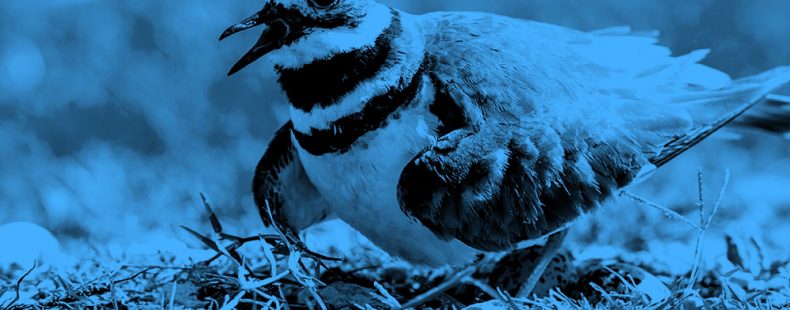As the weather warms and the flowers start to bloom, you may have noticed an increase in the different types of birdsong you hear each day. Birds’ songs and calls serve many purposes, from warning flocks of predators to helping birds catch the attention of potential mates. In the cases of the birds on this list, their songs and calls also inspired their names.
The origins of these kinds of bird names are what’s called imitative, meaning the name imitates the sound that the thing (in this case, a bird) makes.
Cup an ear and meet 13 special birds who sing their own names. Chances are some of them have introduced themselves to you already!
chickadee
The multiple North American birds known as chickadees belong to the titmouse family. The black-capped chickadee and the Carolina chickadee are both common and are almost identical, so most birders distinguish them by song or call. The call of the black-capped sounds like “chicka-dee-dee-dee.”
pewee
If you’re walking outside and hear a bird call out “pee-oo-wee,” it might be a pewee. It’s one of the class of birds known as flycatchers (due to catching insects in flight). There are several different kinds of pewees, including the eastern and western wood pewee.
phoebe
A phoebe is a type of small bird whose unique call (“fee-bee”) is often sounded with what sounds like a hint of annoyance, like someone scolding a person named Phoebe. Also a flycatcher, it’s known for its habit of twitching its tail when perching. These birds can be found as far north as Alaska.
bobwhite
The bobwhite is a type of quail that gets its name from its whistling call, which moves up in pitch to clearly sound out “bob-white.” Most bobwhites have mottled reddish-brown, black, and white plumage.
What’s the difference between a crow and a raven?
whippoorwill
What’s that sound? If you’re out at night, it might be a whippoorwill. These nocturnal North American members of the genus Caprimulgus vociferus are identified by their gray, black, white, and tawny plumage, but they’re more often heard than seen. This is especially due to their persistent call, which they sometimes repeat as many as 400 times without stopping! These birds can be found across the North American continent, from Canada to the Central American isthmus.
chuck-will’s-widow
The chuck-will’s-widow is similar to the whippoorwill, especially when it comes to repeating its unique call—of which its name is a fanciful representation. These birds have been known to call continuously, sometimes more than 800 times! A type of bird known as a goatsucker (due to an ancient and false belief that they drank goat’s milk), the chuck-will’s-widow is found in the swamps, woods, and rocky uplands of the Southern US.
bobolink
Bobolink is the name for a type of “common North American songbird that winters in South America.” Their name is taken from a shortened form of what some English speakers thought part of their complex song sounded like: the name Bob o’ Lincoln. Female bobolinks are generally brown, while males display black, white, and yellow plumage during mating season. Historically, the bobolink was also sometimes called a rice bird due to its penchant for invading rice fields.
flicker
Flickers are “any of several American woodpeckers of the genus Colaptes.” Depending on the type, flickers often have a brightly colored tail that matches the underside of their wings. They’re also noted for taking insects from the ground as well as trees with the help of their sticky, acidic saliva. Though flicker was first recorded in reference to birds in the 1800s, some woodpecker species have hundreds of local names.
killdeer
A killdeer is “a large brown-and-white North American plover with two black breast bands and a noisy cry.” Their cry comes in the form of a single whistled note or a more shrill, two-syllable iteration of “killdeer.” But calls aren’t the only things these birds are known for. They also protect themselves and their nest from predators by performing a “broken wing distraction,” which consists of uttering their loud call and dragging one wing as if injured.
towhee
There are several types of towhees in this family of long-tailed North American finches. The towhee is named for a call, but birders also know the Eastern Towhee for its distinct song, which is interpreted as sounding like “drink-your-tea.” Towhee was first recorded in English in the 1720s.
pipit
Pipits are “any of various songbirds of the genus Anthus, having brownish speckled plumage and a long tail.” Similar to larks in coloring, pipits are sometimes called fieldlarks or titlarks. The common name pipit is most likely imitative of their call, which sounds like a rising “pi-pit.”
dickcissel
If you live in the Eastern or Central parts of the US, it’s possible you’ve heard the call of the dickcissel. This bird is “a bunting, having a brownish back streaked with black and a yellowish breast.” Their call often sounds like a buzzy “dick-see-see,” hence their unique name. Dickcissel has been in use in English since the late 1800s.
cuckoo
Just seeing the word cuckoo might make you think of the distinctive chiming clock of the same name. In reality, cuckoo calls can vary greatly, depending on the type of cuckoo bird (there are several in the family Cuculidae). Some cuckoos make more of a “ka-ka-kow” sound, while others make a “kwik-kwik.” The common European cuckoo is the one that makes the famous clock sound.
Take the quiz
Consider yourself a bona fide “bird”smith now? If bird songs and their names is your personal calling, you should be ready to take our quiz on this topic. You can also help your vocab skills take flight by reviewing our word list when you need to.














